The "Throne" of Epicurus
The situation is entirely different when we come to the portraits of the Epicureans. They never taught publicly but instead withdrew to Epicurus' garden outside the city the Kepos, to live together—more like a gathering of friends, a commune, or a sect than a school—seek-
ing the path to happiness and pleasure without disturbance and fear, under the guidance of a teacher of surpassing insight. The goal was a life of "joy and pleasure" by reaching a state of "painlessness of the body" and "lack of excitement of the soul." In Athens the disciples of Epicurus were so closely identified with a life outside the community of the polis that they were often referred to simply as "those from the Garden" (Sext. Emp. Math. 9.64). It is therefore highly improbable that any public statues were put up in the third century in honor of these men who so ostentatiously withdrew from the civic and political life of the city. More likely, the portraits stood in the Kepos itself, at least in the early period, and served there to recall Epicurus and his friends Metrodorus, Hermarchus, and Polyaenus, who were also known as "guides" or "leaders" (kathegemones ) and enjoyed the particular devotion of pupils who were referred to as kataskeuazomenoi .[24] The existence of a well-known "mnema of the Epicureans" in the Kepos is explicitly attested (Heliod. Aeth. 1.16.5).
We are fortunate to possess copies that give a good idea not only of the statue of Epicurus, but of those of his friend Metrodorus and his successor Hermarchus. Probably all three were put up soon after the subject's death, in 277 (Metrodorus), 270 (Epicurus), and 250 (Hermarchus).[25]
If we take a look at these three Epicurean statues (figs. 62–64), on the one hand (they are all more or less fully preserved in copies or can be reconstructed), and the statue of Chrysippus (cf. fig. 54), on the other, it is immediately clear both how closely all the Epicureans adhere to the same manner of pose and appearance and how fundamentally different these are from the image of the Stoic. Instead of the Stoic expression of mental strain and the hunched-over body, all three Epicureans sit calmly and quietly in classically balanced poses, the mantle carefully draped about them.
Even when seated they maintain a kind of contrapposto between the rear leg actively thrust back and the forward leg relaxed, as well as a comparable chiastic positioning of the arms. For them, evidently, thinking is not such hard work that it would be reflected in the body. The display of conventionalized standards of behavior, as in the citizen image of the fifth and fourth centuries, comes naturally and effortlessly. This is particularly noticeable in the statues of Epicurus and
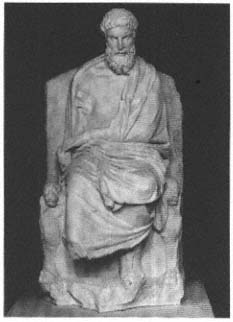
Fig. 62
Epicurus (ca. 342–270). Reconstruction by K.
Fittschen of the statue presumably set up after his
death. Göttingen University, Abgußsammlung.
Hermarchus in the prescribed wrapping up of the left arm. This correct, though rather "public," posture hardly seems to suit the private image of a man quietly seated in contemplation and presents in any event a striking contrast to Chrysippus' intense concentration on intellectual pursuits or the psycho-motor tension and movement of statues related to that of Chrysippus.
This unmistakable gesture of the Epicureans can be understood only as an explicit and self-conscious indication of a desire to hold to the old traditions, a token of virtue and modesty, at a time when these very values were being called into question by other members of Athenian society. Epicurus and his friends quite ostentatiously attach great importance to the proper behavior. Anyone who withdrew from the
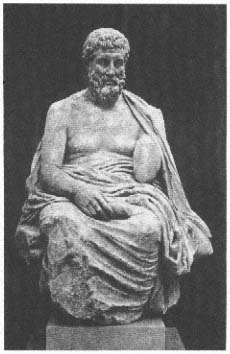
Fig. 63
Metrodorus (ca. 331–277). Reconstruction of a
statue set up after his death. Once Copenhagen,
Ny Carlsberg Glyptotek.
city, like "those from the Garden," was well advised to insure that in spite of this he appeared to be an irreproachable citizen. Indeed, Epicurus by no means rejected the rules of society but rather understood them as the prerequisite to a philosophical life of inner happiness. The maintenance of the proper citizen etiquette was taken for granted in the Kepos.[26]
The elegant wavy hair of Epicureans, the locks carefully arranged on the forehead, and especially the strikingly "classical" stylization of their beards (figs. 66–68) all demonstrate how important they considered a cultivated appearance that was based on the ideals of the past. The wearing of a beard—even a carefully tended beard like those of
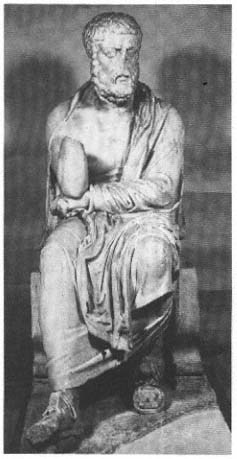
Fig. 64
Hermarchus (born ca. 340). Underlife-size
Roman copy of a statue ca. 250 B.C.
Florence, Museo Archeologico.
respectable Athenian citizens of an earlier age—had by now become a token of otherness. And yet the handsome Epicurean beard conveys a very different set of values from the unkempt or crudely trimmed beard of the Stoics, not to mention that of the Cynics. For the Epicureans, the beard implies not only an acceptance of the traditions of the polis, but also an identification with the upper class.
While at first glance the three statues of Epicureans look very similar, there are in fact important differences, which reflect the strict hierarchy that obtained in the Kepos. Epicurus sits on an impressive "throne," Metrodorus on a backed chair, and Hermarchus on a simple stone block.[27] Some have likened Epicurus' chair, with its ornamental lion-paw feet, to the thrones of the gods, and thereby linked it to the hero cult that was established for the founder of the Kepos after his death. This seems to me, however, unlikely, since Epicurus himself is not depicted as a hero, but in every respect as an Athenian citizen. For a contemporary viewer, a more obvious comparison would be with the prohedria (the front-row seats) in the Theatre of Dionysus, reserved for priests and outstanding citizens, as well as for benefactors of the city. The association would have suggested itself on account of the shape of the seat (fig. 65), especially since the elaborate seat of the priest of Dionysus, with its lion-paw feet, in the middle of the front row, stood in the same relation to the other seats of honor as Epicurus' throne to the backed chair of Metrodorus. The Kepos has thus usurped this symbol of signal public honor for officials and dignitaries, in order to mark Epicurus' achievements and his position within the school. In this way the great wise man, who showed the way to a happy life, was singled out by his pupils as the highest spiritual authority.[28]
Another conceivable association would be that of an academic "chair." As early as the time of the Sophists, an especially impressive seat seems to be a sign of the instructor's special authority and dignity. Plato portrays the Sophist Hippias of Elis giving instruction from a thronos, while his pupils sat around him on stone benches (Prt. 315). But, as we shall see, Epicurus is in fact not shown as a teacher giving instruction, so that the connotation of the academic chair is unlikely.
Against the background of the Classical image of the Athenian citizen, this kind of honor represents something new. The singling out of Epicurus from the other two kathegemones makes it clear that the Epicureans were not concerned with a search for truth through persuasive argumentation and passionate discussion, like the followers of Chrysippus, but rather with devotion to and perpetuation of a unique spiritual guide and teacher.
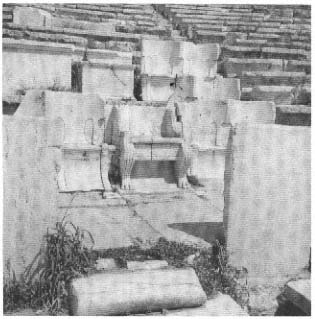
Fig. 65
Honorary seats in the Theatre of Dionysus in Athens.
The same hierarchy can also be clearly detected in the faces of the three portraits. Epicurus' is marked by a curious contrast between the restless and powerfully muscled philosopher's brow and the otherwise placid expression of the face (fig. 66). Yet the brow is still different from, say, Zeno's or Chrysippus', where the mental effort looks forced and strained. Epicurus' eyebrows are raised, but hardly in motion. The raised brows are a token of superiority, reflecting his absolute authority. The powerful muscles above the brows can therefore not be understood as an expression of a momentary mental struggle, especially when the body is so relaxed. Apparently the sculptor wanted to express the idea of tremendous intellectual capacity, a state of being rather than a sudden action.[29]
Metrodorus' brow, on the other hand, does not betray even a trace
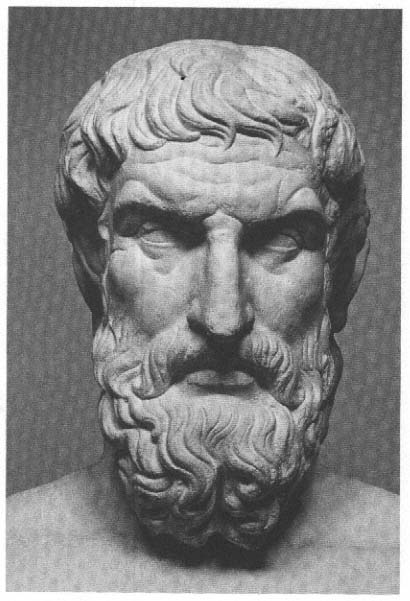
Fig. 66
Epicurus on a double herm with Metrodorus. Rome, Capitoline Museum. (Cast.)
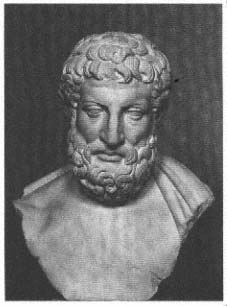
Fig. 67
Bust of Metrodorus. Rome, Capitoline
Museum. (Cast.)
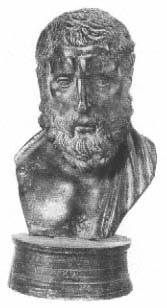
Fig. 68
Small bronze bust of Hermarchus.
H: 20 cm. Naples, Museo Nazionale.
of intellectual effort (fig. 67). Rather, its serenity, lack of expression, and perfect balance strike us more as an echo of Classical citizen portraits. This was, it would seem, precisely the intention. The Classical formula for characterizing a distinguished man in middle age is taken up and quoted, in order to make visible certain goals of Epicurus' teachings, such as inner tranquility and a life of enjoyment. In this way, the carefully tended hair and beard, as well as the elegant manner of dress and seated posture forge an association with the polis values of the past.[30]
With Hermarchus, however, we do seem to sense a measure of mental strain, or perhaps, concern (fig. 68). In the better copies, the brows are gently drawn together, and the wide fringe of hair emphasizes the severity of this portrait of old age. Like Epicurus, Hermarchus was a native of Mytilene on Lesbos, and they had come together to Athens
and there lived and philosophized together for more than forty years. Hermarchus was thus already an old man when, after Epicurus' death, he became head of the Kepos and devoted himself to preserving his friend's heritage as faithfully as possible.[31]
Hermarchus' dress and pose (cf. fig. 64), as we have seen, deliberately imitate those of Epicurus, but with an important difference in the pose of the head and probably also of the right arm. Hermarchus' raised arm is a gesture of teaching, and his head is raised and turned to the side, as if toward an interlocutor. Epicurus, by contrast, bent his head and looked out in front of him, as Fittschen's reconstruction with casts has confirmed (fig. 62). The lower right arm, like Metrodorus' left, was gently drawn back toward the body and turned inward. The drooping shoulder also suggests a quietly relaxed positioning of the arm.[32] We may infer from this difference that Hermarchus was shown more as the teacher, Epicurus as the tranquil thinker marked by inner concentration. This in turn reflects the different roles that they played: Epicurus is the great pioneering thinker, remote and unattainable on his seat of honor; Hermarchus, the loyal disciple who preserves and propagates the inheritance of the master.